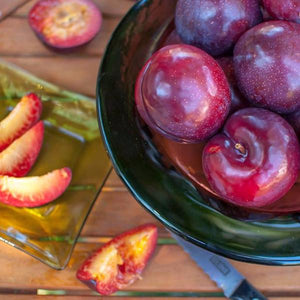When Are Plums In Season
Discover the best times to enjoy fresh plums and learn about their seasonal availability.
Writer :raveen
Post on :Aug. 9, 2024
Last Update On :Nov. 30, 2024

A Comprehensive Guide to Knowing When Are Plums in Season
Plums, with their sweet and tangy flavor, are one of the most beloved fruits around the world. Whether you enjoy them fresh, dried as prunes, or incorporated into a recipe, plums bring a delightful burst of flavor to your palate. However, to truly relish their taste and freshness, it's essential to know when are plums in season. In this guide, we’ll explore the prime plum seasons, regional variations, and tips to enjoy them at their best.
Understanding When Are Plums in Season
The question of when are plums in season can vary based on geography and climate. In general, plums are harvested during the warmer months, typically from late spring to early autumn. Here’s an overview:
-
Peak Season for Fresh Plums:
- In the United States, the primary season for plums is between May and September.
- California, being the largest producer of plums, sees its peak harvest in June, July, and August.
-
Off-Season Availability:
- Outside the peak months, plums are often imported from countries like Chile and South Africa, ensuring year-round availability in grocery stores.
- However, the quality and taste of off-season plums may not match the locally grown varieties harvested during their natural season.
Regional Variations: When Are Plums in Season Across the Globe
The seasonality of plums differs worldwide, depending on the hemisphere and local climate. To understand when are plums in season, here’s a breakdown by region:
-
Northern Hemisphere:
- United States and Canada: May to September
- Europe (e.g., Spain, Italy): June to October
- Asia (e.g., China, Japan): June to September
-
Southern Hemisphere:
- Australia and New Zealand: November to February
- South America (e.g., Chile): December to March
By knowing these regional differences, you can plan your plum purchases based on local and imported varieties.
Types of Plums and Their Seasonal Availability
Plums come in numerous varieties, each with its unique flavor and color. Knowing the type of plum can help you determine when are plums in season for your favorite kind.
-
European Plums:
- Examples: Damsons, Greengages, Mirabelles
- Season: Late summer (July to September)
-
Japanese Plums:
- Examples: Santa Rosa, Satsuma
- Season: Early summer (May to July)
-
Wild Plums:
- Found in forests and often used for jams and preserves.
- Season: Late summer to early autumn
-
Pluots (Plum-Apricot Hybrids):
- Season: Midsummer (June to August)
How to Identify Ripe Plums
When you know when are plums in season, the next step is identifying ripe and ready-to-eat fruit. Here are some tips:
-
Check the Color:
- Ripe plums exhibit deep, vibrant colors depending on their variety. For instance, red plums turn darker as they ripen.
-
Feel the Texture:
- Gently press the plum. A ripe one will feel slightly soft but not mushy.
-
Smell the Fruit:
- Ripe plums emit a sweet, fragrant aroma, indicating their readiness to eat.
By purchasing plums during their season, you’ll get the freshest and most flavorful fruit.
Benefits of Eating Plums in Season
Consuming fruits during their natural season offers several advantages. Knowing when are plums in season ensures you enjoy these benefits:
-
Better Taste and Nutrition:
- Plums harvested in season are fresher and packed with more nutrients compared to those picked prematurely and ripened artificially.
-
Cost-Effective:
- Seasonal plums are more affordable due to their abundance during the harvest months.
-
Eco-Friendly:
- Eating local, in-season plums reduces the carbon footprint associated with importing off-season produce.
Top 3 Ways to Enjoy Plums
Knowing when are plums in season allows you to make the most of this fruit. Here are three popular ways to incorporate plums into your meals:
-
Fresh Snacks:
- Enjoy plums as they are, washed and fresh, for a quick and healthy snack.
-
Plum Desserts:
- Bake plum tarts or cobblers to satisfy your sweet tooth.
- Make plum preserves or jams to enjoy the fruit’s flavor year-round.
-
Savory Dishes:
- Use plums in salads, sauces, or marinades to add a sweet tang to savory recipes.
Tips for Storing and Preserving Plums
Once you’ve identified when are plums in season and bought a fresh batch, proper storage is key to maintaining their quality.
-
Short-Term Storage:
- Store ripe plums in the refrigerator to extend their shelf life by 2-3 days.
-
Long-Term Preservation:
- Freeze plums after removing the pits for use in smoothies or baking.
- Prepare and can plum preserves for year-round enjoyment.
-
Ripening Tip:
- If you’ve purchased slightly underripe plums, place them in a paper bag at room temperature to speed up the ripening process.
Frequently Asked Questions About When Are Plums in Season
-
Are plums available year-round?
- While fresh, local plums are seasonal, imported plums are available year-round.
-
Can I find organic plums in season?
- Yes, organic plums are often available during the peak summer months. Check farmers’ markets for the freshest organic options.
Conclusion
Understanding when are plums in season helps you enjoy this delicious fruit at its freshest and most flavorful. From late spring to early autumn in the Northern Hemisphere to late winter in the Southern Hemisphere, plums are a seasonal delight that enriches your diet. By consuming them during their peak, you not only support local farmers but also ensure maximum taste and nutritional benefits.
So, the next time you’re craving a juicy and sweet snack, remember to check when are plums in season and savor the best nature has to offer!
Categories
-
Games

-
Apparel and Accessories

-
Electronics

-
HairCare

-
Clothings

-
Body Jewelery

-
Footwear

-
Vehicles

-
Bags

-
Kids Clothings

-
Cosmetics

-
Gifts

-
Bedding

-
Jewelry

-
Haircare

-
Home Appliances

-
Fruits And Vegetables

-
Fitness Equipment

-
Water Filters

-
Sports Equipment

-
Saddles

-
Bags And Suitcase

-
Pets Gear

-
Sports Equipmet

-
Cars Accessories

-
Vehicles

-
Vitamins and Supplements

-
Camera

-
Home Decor

-
Hotel

-
Automotive

-
Flowers

-
Bedding

-
Clothings

-
Phones

-
Computer Accessories

-
clothing and accessories

-
Accessories

-
Health And Wellness

-
Ebikes

-
Games

-
Clothings

-
tech

-
Automotive Accessories

-
Skincare

